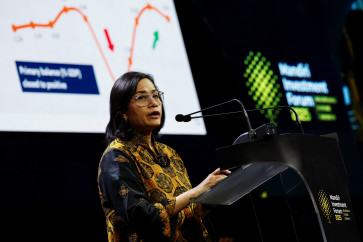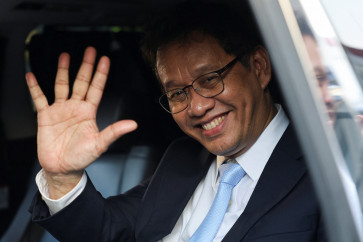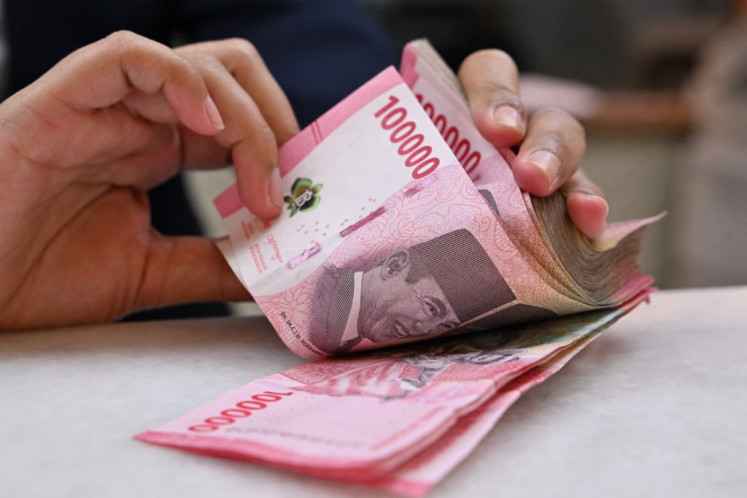Popular Reads
Top Results
Can't find what you're looking for?
View all search resultsPopular Reads
Top Results
Can't find what you're looking for?
View all search resultsIORA Summit 2017 Jakarta: Jokowi’s Global Maritime Axis doctrine key to Indonesia’s future
Show of commitment: President Joko “Jokowi” Widodo (center) inspects the Navy’s KRI Imam Bonjol 383 vessel after leading a limited Cabinet meeting regarding the Natuna Islands on board the warship, which is used to capture Chinese ships caught fishing in Natuna waters
Change text size
Gift Premium Articles
to Anyone
S
span class="caption">Show of commitment: President Joko “Jokowi” Widodo (center) inspects the Navy’s KRI Imam Bonjol 383 vessel after leading a limited Cabinet meeting regarding the Natuna Islands on board the warship, which is used to capture Chinese ships caught fishing in Natuna waters. The move was made as part of the President’s commitment to his Global Maritime Axis vision, which he launched in 2014.(ANTARA)
Prior to becoming Indonesia’s seventh president in 2014, Joko “Jokowi” Widodo was a small furniture trader in his hometown Surakarta, Central Java. He studied forestry at Gadjah Mada University in Yogyakarta, having no experience in foreign policy before becoming president.
However, Jokowi, the former mayor of Surakarta (2005 -2012) and Jakarta governor (2012-2014), announced a major shift in Indonesia’s foreign policy direction on Oct. 20, 2014, the first day of his presidency.
He said all Indonesians must work hard to turn Indonesia into a maritime nation. In less than one month, during the East Asia Summit meeting in Myanmar’s capital Naypyitaw in November 2014, Jokowi unveiled his historic “Poros Maritime Dunia” (Global Maritime Axis) doctrine.
According to Jokowi, the world has witnessed a tectonic change in global and regional power relations in the 21st century, thanks to the rise of China and other Asian countries.
“Indonesia realizes that a substantial transformation is taking place in the 21st century. The center of gravity of the geo-economic and geo-political world is shifting from West to East. Asian countries are on the rise,”
the President said in his speech in front of global leaders ranging from the then US President Barack Obama to Chinese Prime Minister Li Keqiang.
As the world’s largest archipelagic state with its strategic location at the cross roads of the Indian and the Pacific Oceans, Jokowi said, Indonesia must assert itself as the World Maritime Axis.
“As a maritime country, this position opens opportunities for Indonesia to develop regional and international cooperation for the prosperity of the people,” Jokowi said.
This new doctrine, which extends Indonesia’s sphere from being ASEAN-centered to a much bigger Indo-Pacific region, mainly focuses on trade, infrastructure, security and a bigger role for Indonesia in regional and global diplomacy.
Signature vision: President Joko “Jokowi” Widodo (second left), accompanied by Foreign Affairs Minister Retno LP Marsudi (right), attends the ninth East Asia Summit in Myanmar, where he announced his much-awaited signature Global Maritime Axis doctrine, in 2014.(ANTARA)
Jokowi’s doctrine has five main pillars. They are:
1. Rebuild Indonesia’s maritime culture. As a country that is made up of 17,000 islands, the nation must realize that its future is largely determined by how it manages the surrounding oceans.
2. Indonesia will maintain and manage sea resources with a focus on establishing sovereignty over sea-based food products.
3. The country will prioritize infrastructure and maritime connectivity development by building sea tolls and deep sea ports while also improving the shipping industry, logistics and maritime tourism.
4. Through maritime diplomacy, Indonesia must end the sources of conflict at sea, such as fish thefts, violation of sovereignty, territorial disputes, piracy and pollution.
5. As a country that is the bridge between two oceans, Indonesia is obligated to build its maritime defense power.
One key objective of Jokowi’s doctrine was to build a sea toll (through upgrading port infrastructure), which will enhance inter-island connectivity that can boost economic activities within the country. If this is achieved, it can transform Indonesia into a maritime regional hub.
Another key point of Jokowi’s doctrine was to upgrade Indonesia’s maritime defense power, by adding more patrol boats and battle ships.
“Indonesia is obligated to build its maritime defense power. This is necessary not only to secure its maritime wealth and sovereignty but also to take responsibility for safeguarding navigation safety and maritime security,” Jokowi said.
Jokowi’s maritime doctrine, which is bold and unprecedented, is vital for the country’s future. On one side, it revives the Indonesian economy, enhances trade and transforms into a major maritime power. It puts Indonesia at the center-stage of two maritime worlds, the Indian Ocean and the Pacific Ocean.
People from outside Indonesia may ask why Indonesia is now focusing on maritime affairs.
As the world’s largest archipelagic state with 17,000 islands, Indonesia has 6 million square kilometers of maritime area under its jurisdiction, two-thirds of Indonesia’s territory is water.
In the past Indonesia was a respectful maritime power for more than 800 years. The famous Sriwijaya kingdom (8th to 12th century) was a maritime power on Sumatra, while Majapahit kingdom (13th to 15th century) was another maritime power on Java.
Maritime life is part and parcel to Indonesian society. It can not be separated. That is why Jokowi wants to revive Indonesia’s glorious history by turning it into a major maritime power.
Jokowi strongly believes in the famous slogan jalasveva jayamah (in the ocean we triumph).
Jokowi has special interest in the Indian Ocean; he put it as a priority in his agenda for regional cooperation in his election manifesto. He wants Indonesia to play a bigger role in the Indian Ocean Rim Association (IORA).
As a chair of IORA, Indonesia has brought new direction to IORA with an emphasis on regional cooperation and has elevated the normal annual ministerial meeting to a summit of heads of government/state. For the first time, Indonesia will host an IORA Summit in Jakarta on March 7 (Tuesday).
Indonesia is strongly committed to peace and stability in the Indian Ocean.
“Through IORA, we have a responsibility to ensure that our region remains stable and peaceful,” Foreign Minister Retno LP Marsudi said some time back.
“We want the Indian and Pacific Oceans to remain peaceful and safe for world trade instead of being battlefields for natural resources, territorial conflicts and maritime supremacy,” Jokowi said.
Echoing a similar view, Indonesia’s maritime expert and former diplomat Hasyim Djalal described the Indian Ocean as the future of the world.
“I personally feel that the Atlantic Ocean was the ocean of the past, the Pacific Ocean is the ocean of the present and the Indian Ocean is the ocean of the future,” Hasyim wrote in The Jakarta Post recently.











